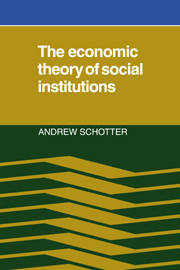Book contents
3 - A mathematical theory of institution creation
Published online by Cambridge University Press: 05 November 2011
Summary
In this chapter I present a mathematical theory of institution creation. Being only a theory as opposed to the theory, it cannot be considered the only possible approach that one could take. However, it is my feeling that the model presented here does contain two elements that any successful theory of institution creation must contain. The first is a theory of norm creation and change which must be included in any theory that tries to depict the process of the creation of social institutions as we have defined them (i.e., as commonly adhered to regularities in behavior created to solve recurrent societal problems), because it is upon these norms that the regularities in behavior we are calling social institutions can be built. More precisely, we have defined social institutions or conventions as regularities (R) in the behavior of members of a population when they are agents in recurrent situations, Γ, which are such that:
Everyone conforms to R.
Everyone expects everyone else to conform to R.
Either everyone prefers to conform to R on condition that the others do if Γ is a coordination problem, in which case uniform conformity to R is a coordination equilibrium, or
If anyone ever deviates from R, it is known that some or all of the others will also deviate and the payoffs associated with the recurrent play of Γ using these deviating strategies are worse for all agents than is the payoff associated with R.
Now, notice that for a social institution or regularity R to be a well-functioning one, everyone must “expect everyone else to conform to R.”
- Type
- Chapter
- Information
- The Economic Theory of Social Institutions , pp. 52 - 108Publisher: Cambridge University PressPrint publication year: 1981



